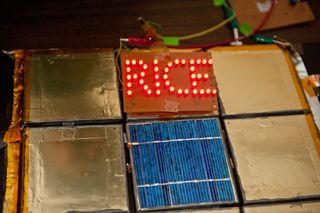High-Tech Paint Turns Any Surface Into a Battery

The rechargeable lithium-ion batteries now found in many mobile phones and laptops may one day be sprayed like paint onto virtually any surface, potentially ushering in a new generation of thin, flexible devices, researchers say.
Spray-paintable batteries even might become available to the general public someday at hardware stores, the scientists added.
Lithium-ion batteries power most portable electronics nowadays, but their spiral, jelly-roll-like design generally limits them to rectangular or cylindrical shapes.
['Smart Clothing' Could Become New Wearable Gadgets]
Now researchers have succeeded in painting these batteries onto a diverse range of surfaces, including glass slides, stainless steel, flexible plastic sheets, glazed ceramic tiles, and even the curved side of a beer mug.
"We can convert almost any object to a battery," Neelam Singh, a materials scientist at Rice University in Houston, told InnovationNewsDaily.
He and other researchers spent painstaking hours formulating paints that could function as the separate components of a battery. In their search, they looked at materials as diverse as carbon nanotubes and ultrafine graphite powders. They next painted these ingredients in layers in the proper order onto surfaces to create the batteries.
Sign up for the Live Science daily newsletter now
Get the world’s most fascinating discoveries delivered straight to your inbox.
"Spray painting is already an industrial process, so it would be very easy to incorporate this into industry," Singh said.
Batteries that the researchers printed onto nine ceramic bathroom tiles could readily power 40 red LED lights. One of these battery tiles was topped with a solar power cell that helped charge the batteries, suggesting the researchers could give any surface the capability to both harvest and store energy.
The material onto which the batteries were painted apparently had no effect on the performance of the devices. This suggests this technology could find its way into a wide range of construction materials and household objects.
"You could turn your home into a battery," Singh said.
The researchers do caution that fabricating these batteries requires the use of toxic, flammable and potentially corrosive materials in an oxygen-free and moisture-free environment. Employing safer battery materials along with oxygen- and moisture-resistant paints could allow even the general public to spray-paint batteries.
[Transparent Batteries Help Mobile Devices Go See-Through]
"People paint their homes and cars often," Singh said. "I think it will be possible for people to paint batteries themselves."
The scientists have filed for a patent on their work. They detailed their findings online June 28 in the journal Scientific Reports.
This story was provided by InnovationNewsDaily, a sister site to LiveScience. Follow InnovationNewsDaily on Twitter @News_Innovation, or on Facebook.

Most Popular



